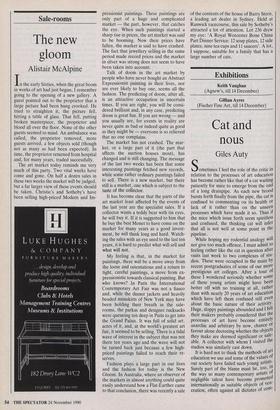Sale-rooms
The new gloom
Alistair McAlpine
n the early Sixties, when the great boom in works of art had just begun, I remember going to the opening of a new gallery. A guest pointed out to the proprietor that a large picture had been hung crooked. He tried to straighten it, the picture fell, hitting a table of glass. That fell, putting broken masterpiece, the proprietor and blood all over the floor. None of the other guests seemed to mind. An ambulance was called, the proprietor removed, more guests arrived, a few objects sold (though not as many as had been expected). In time, the proprietor returned from hospital and, for many years, traded successfully.
The art market today reminds me very much of this party. Two vital weeks have come and gone. On half a dozen sales in these two weeks the market will be judged, hut a far larger view of these events should be taken. Christie's and Sotheby's have been selling high-priced Modern and Im- pressionist paintings. These paintings are only part of a huge and complicated market — the part, however, that catches the eye. When such paintings started a sharp rise in prices, the art market was said to be booming. Now their prices have fallen, the market is said to have crashed. The fact that jewellery selling in the same period made record prices and the market in silver was strong does not seem to have been taken into account.
Talk of doom in the art market by people who have never bought an Abstract Expressionist painting in their lives, nor are ever likely to buy one, seems all the fashion. The predicting of doom, after all, is an attractive occupation in uncertain times. If you are right, you will be consi- dered brilliant and, in any case, predicting doom is great fun. If you are wrong — and you usually are, for events in reality are never quite as bad or indeed quite as good as they might be — everyone is so relieved that no one complains.
The market has not crashed. The mar- ket, or a large part of it (the part that affects the auction houses most), has changed and is still changing. The message of the last two weeks has been that some interesting paintings fetched new records, while some rather ordinary paintings failed to sell. There is a new market, but there still is a market, one which is subject to the taste of the collector.
It has become clear that the parts of the art market least affected by the events of the last year are the specialist sales. If a collector wants a teddy bear with tin eyes, he will buy it. If it is suggested to him that he buy the best Monet to have come on the market for many years as a good invest- ment, he will think long and hard. Watch- ing the sales with an eye used to the last ten years, it is hard to predict what will sell and what will not.
My feeling is that, in the market for paintings, there will be a move away from the loose and ostentatious and a return to tight, careful paintings, a move from ex- pressionistic towards classical painting. But who knows? In Paris the International Contemporary Art Fair was not a fiasco and, while the dinner jackets and heavily beaded miniskirts of New York may have been holding their breath in the sale- rooms, the parkas and designer rucksacks were queueing ten deep in Paris to get into the Grand Palais. It was full of solid art, acres of it, and, at the world's greatest art fair, it seemed to be selling. There is a tidal wave of interest in the subject that was not there ten years ago and the wave will not be turned back just because a few high- priced paintings failed to reach their re- serves.
Fashion plays a large part in our lives and the fashion for today is the New Gloom. In Australia, where an observer of the markets in almost anything could quite easily understand how a Flat-Earther came to that conclusion, there was recently a sale of the contents of the house of Barry Stern, a leading art dealer in Sydney. Held at Ranwick racecourse, this sale by Sotheby's attracted a lot of attention. Lot 236 drew my eye: 'A Royal Worcester Bone China Part Dinner Service: 12 soup plates, 12 side plates, nine tea cups and 11 saucers'. A lot, I suppose, suitable for a family that has a large number of cats.


































































 Previous page
Previous page